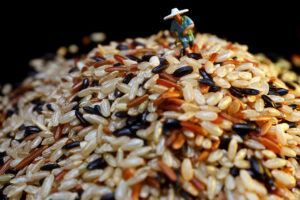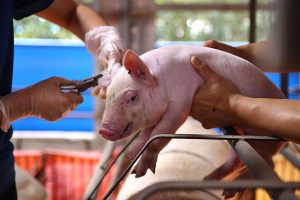By Kenneth Christiane L. Basilio
THE GOVERNMENT is open to adjusting tariff rates on rice imports if global prices show a steady decline, National Economic and Development Authority (NEDA) Secretary Arsenio M. Balisacan said on Monday.
“If world prices are going down, then you have to do what you can to adjust the tariff, that’s what many countries do,” he told reporters on the sidelines of a forum on Monday.
President Ferdinand R. Marcos, Jr. last week issued Executive Order (EO) No. 62, cutting tariffs for different agricultural imports like rice, pork, poultry and corn to 15% from 35% until 2028.
“If the situation changes, the government must have that flexibility to re-examine its tools,” Mr. Balisacan said.
Under the order, the in-quota and out-quota tariff rates for rice will be reviewed every four months. The NEDA is tasked to submit its recommendations to the President through the Office of the Executive Secretary.
Meanwhile, retail prices of rice are expected to drop to as low as P40 per kilo as early as July once EO 62 takes effect, an industry executive said.
“We expect that the prices for well-milled rice… to drop to P45 to P46 [per kilo], for regular-milled rice, it will range between P40 and P42, and P43 [per kilo]. For premium rice, it would range around P47 to P48 [per kilo],” Orly Manuntag, spokesperson of the Grain Retailers Confederation of the Philippines, said in Filipino during a press conference with leaders of the House of Representatives.
EO 62 is set to take effect on July 6 or 15 days after it was published, Department of Agriculture Assistant Secretary and Spokesperson Arnel V. de Mesa said on Saturday.
House Speaker and Leyte Rep. Ferdinand Martin G. Romualdez said the lower tariffs will likely bring down average rice prices to P45 per kilo in Metro Manila.
The tariff cut on imported rice is expected to tame inflation as the staple product is a “significant contributor” to the consumer price index, Security Bank Corp. Chief Economist Robert Dan J. Roces told BusinessWorld in a Viber message.
“While estimates predict a reduction of 0.4 to 1.8 percentage points, the actual impact depends on how much domestic rice prices adjust and how fast it adapts,” he said. “The fast-tracked approval could lead to quicker relief, but long-term effects on farmers and the need for complementary measures require further National government action.”
Mr. Roces noted the implementation of EO 62 is “necessary and timely” amid the persistent rice inflation.
Inflation accelerated to a six-month high of 3.9% in May. In particular, rice inflation remained elevated although slightly easing to 23% in May from 23.9% in April.
The lower rice tariffs would benefit low-income households who bear the brunt of spiraling rice prices, Mr. Roces added.
However, lowering tariffs on imported rice could be detrimental to the domestic rice industry if left unchecked, Eleanor L. Roque, tax principal of P&A Grant Thornton, said.
“Lowering the cost of imported rice without looking at how the local farmers can compete may be detrimental in the long term,” she told BusinessWorld in a Viber message. “The government should evaluate both short-term and long-term solutions for food sufficiency without neglecting the needs of our local farmers.”
Enrico P. Villanueva, a senior lecturer at the University of the Philippines Los Baños Economics Department, said only 20% of the country’s rice supply is sourced from imports.
“The substantial tariff cut will help ease rice prices, but its impact will be muted by the fact that imports comprise just roughly about 20% of rice supply in the Philippines,” he told BusinessWorld in an X message.
Reducing the rice prices to as low as P40 is not realistic unless the government would only import low-quality rice, Raul Q. Montemayor, national manager of Federation of Free Farmers, told BusinessWorld in a Viber message.
“At current cost, insurance and freight rate of $600 per ton… the exit pier costs would be at P40.71 per kilo,” he said. “Add in profit margins, freight, and handling costs, the retail price will be approximately P50 per kilo.”
“I don’t see how they can sell rice at only P40 per kilo. The only way this can happen is if the cost, insurance, and freight costs go down to $500 or they bring in cheap and low-quality rice,” he added. — with Beatriz Marie D. Cruz






